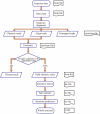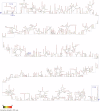RNA architecture of porcine deltacoronavirus genome inside virions detected by vRIC-seq
- PMID: 39402053
- PMCID: PMC11473776
- DOI: 10.1038/s41597-024-03975-w
RNA architecture of porcine deltacoronavirus genome inside virions detected by vRIC-seq
Abstract
Porcine deltacoronavirus (PDCoV) is a newly emerging and special delta coronavirus, which infect mammals such as pigs, cattle and humans, as well as chickens and birds. Exploring RNA structures in the viral genome benefits the understanding of the role of RNA in the lifecycle of viruses. In this study, vRIC-seq is employed to analyze the RNA-RNA interaction in the whole genome structure of PDCoV in virions. About 12.87 and 13.52 million paired reads are obtained in two biological replicates, respectively, with 17.9% and 14.8% of them are identified as valid chimeric reads. These are employed to predict the RNA secondary structure, which is compact and highly structured. A twisted-cyclized conformation is observed in the RNA-RNA interaction map of PDCoV for the first time. 77 multi-way junctions are evenly distributed in the PDCoV genome. Our work provides fundamental structural insights that are essential for understanding the genomic structure and function, genetic evolution, and packaging characteristics of PDCoV.
© 2024. The Author(s).
Conflict of interest statement
The authors declare no competing interests.
Figures






Similar articles
-
Isolation, characterization and transcriptome analysis of porcine deltacoronavirus strain HNZK-02 from Henan Province, China.Mol Immunol. 2021 Jun;134:86-99. doi: 10.1016/j.molimm.2021.03.006. Epub 2021 Mar 16. Mol Immunol. 2021. PMID: 33740580
-
Serial cell culture passaging in vitro led to complete attenuation and changes in the characteristic features of a virulent porcine deltacoronavirus strain.J Virol. 2024 Aug 20;98(8):e0064524. doi: 10.1128/jvi.00645-24. Epub 2024 Jul 16. J Virol. 2024. PMID: 39012141 Free PMC article.
-
Characterization of the Cross-Species Transmission Potential for Porcine Deltacoronaviruses Expressing Sparrow Coronavirus Spike Protein in Commercial Poultry.Viruses. 2022 Jun 5;14(6):1225. doi: 10.3390/v14061225. Viruses. 2022. PMID: 35746696 Free PMC article.
-
Porcine deltacoronavirus infection: Etiology, cell culture for virus isolation and propagation, molecular epidemiology and pathogenesis.Virus Res. 2016 Dec 2;226:50-59. doi: 10.1016/j.virusres.2016.04.009. Epub 2016 Apr 13. Virus Res. 2016. PMID: 27086031 Free PMC article. Review.
-
Epidemiology, pathogenesis, immune evasion mechanism and vaccine development of porcine Deltacoronavirus.Funct Integr Genomics. 2024 Apr 24;24(3):79. doi: 10.1007/s10142-024-01346-7. Funct Integr Genomics. 2024. PMID: 38653845 Review.
References
MeSH terms
Substances
LinkOut - more resources
Full Text Sources
Molecular Biology Databases

